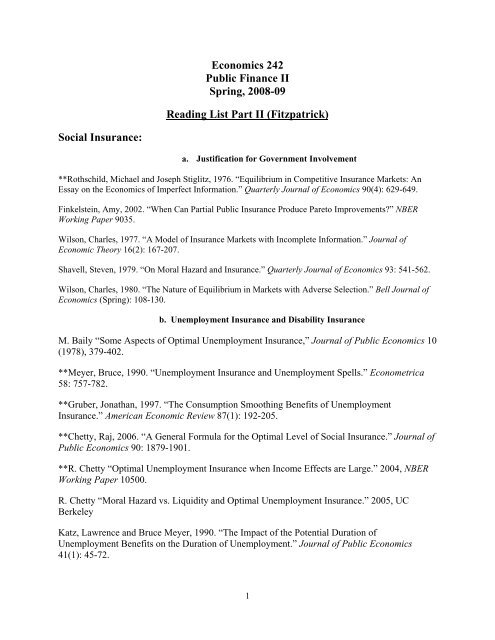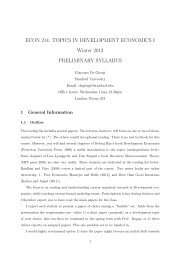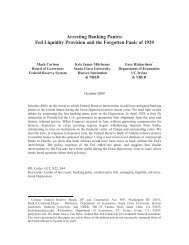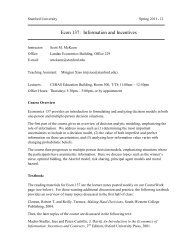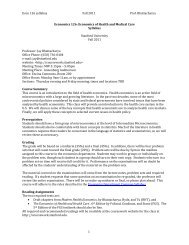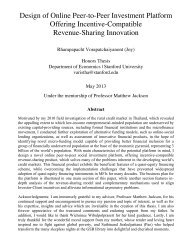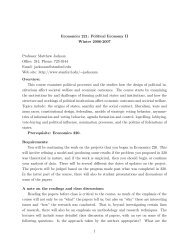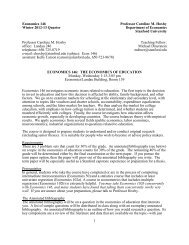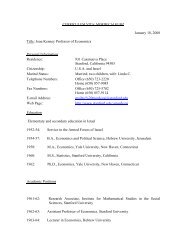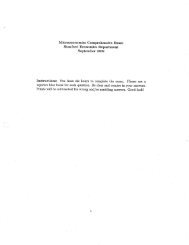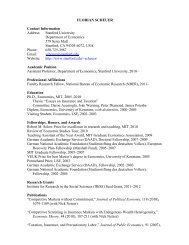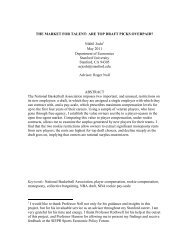Download Econ 242 reading list_2nd half Spr09.pdf - Economics
Download Econ 242 reading list_2nd half Spr09.pdf - Economics
Download Econ 242 reading list_2nd half Spr09.pdf - Economics
Create successful ePaper yourself
Turn your PDF publications into a flip-book with our unique Google optimized e-Paper software.
Social Insurance:<br />
<strong>Econ</strong>omics <strong>242</strong><br />
Public Finance II<br />
Spring, 2008-09<br />
Reading List Part II (Fitzpatrick)<br />
a. Justification for Government Involvement<br />
**Rothschild, Michael and Joseph Stiglitz, 1976. “Equilibrium in Competitive Insurance Markets: An<br />
Essay on the <strong>Econ</strong>omics of Imperfect Information.” Quarterly Journal of <strong>Econ</strong>omics 90(4): 629-649.<br />
Finkelstein, Amy, 2002. “When Can Partial Public Insurance Produce Pareto Improvements?” NBER<br />
Working Paper 9035.<br />
Wilson, Charles, 1977. “A Model of Insurance Markets with Incomplete Information.” Journal of<br />
<strong>Econ</strong>omic Theory 16(2): 167-207.<br />
Shavell, Steven, 1979. “On Moral Hazard and Insurance.” Quarterly Journal of <strong>Econ</strong>omics 93: 541-562.<br />
Wilson, Charles, 1980. “The Nature of Equilibrium in Markets with Adverse Selection.” Bell Journal of<br />
<strong>Econ</strong>omics (Spring): 108-130.<br />
b. Unemployment Insurance and Disability Insurance<br />
M. Baily “Some Aspects of Optimal Unemployment Insurance,” Journal of Public <strong>Econ</strong>omics 10<br />
(1978), 379-402.<br />
**Meyer, Bruce, 1990. “Unemployment Insurance and Unemployment Spells.” <strong>Econ</strong>ometrica<br />
58: 757-782.<br />
**Gruber, Jonathan, 1997. “The Consumption Smoothing Benefits of Unemployment<br />
Insurance.” American <strong>Econ</strong>omic Review 87(1): 192-205.<br />
**Chetty, Raj, 2006. “A General Formula for the Optimal Level of Social Insurance.” Journal of<br />
Public <strong>Econ</strong>omics 90: 1879-1901.<br />
**R. Chetty “Optimal Unemployment Insurance when Income Effects are Large.” 2004, NBER<br />
Working Paper 10500.<br />
R. Chetty “Moral Hazard vs. Liquidity and Optimal Unemployment Insurance.” 2005, UC<br />
Berkeley<br />
Katz, Lawrence and Bruce Meyer, 1990. “The Impact of the Potential Duration of<br />
Unemployment Benefits on the Duration of Unemployment.” Journal of Public <strong>Econ</strong>omics<br />
41(1): 45-72.<br />
1
Card, David, Raj Chetty and Andrea Weber, 2007. “Cash-on-Hand and Competing Models of<br />
Intertemporal Behavior: New Evidence from the Labor Market.” Quarterly Journal of <strong>Econ</strong>omics 122(4):<br />
1511-1560.<br />
Cullen, Julie and Jonathan Gruber, 2000. “Does Unemployment Insurance Crowd out Spousal Labor<br />
Supply?” Journal of Labor <strong>Econ</strong>omics 18: 546-572.<br />
M. Feldstein "Seven Principles of Social Insurance," Challenge, November/December 1976.<br />
c. Workers' Compensation<br />
**A. Krueger "Incentive Effects of Workers' Compensation Insurance" Journal of Public<br />
<strong>Econ</strong>omics, 41, 73-99, 1990.<br />
**L. Summers, "Some Simple <strong>Econ</strong>omics of Mandated Benefits", American <strong>Econ</strong>omic Review<br />
79 (May 1989), 177-183.<br />
**J. Gruber and A. Krueger, "The Incidence of Mandated Employer-Provided Insurance:<br />
Lessons from the Workers' Compensation Insurance," in D. Bradford Tax Policy and the<br />
<strong>Econ</strong>omy 5 (Cambridge, MA: MIT Press, 1991), 111-144.<br />
**D. Card and B. McCall. Is Workers Compensation Covering Uninsured Medical Costs?<br />
Evidence from the Monday Effect" Industrial and Labor Relations Review, 1996, 690-706.<br />
P. Fishback and S. Kantor, “Did Workers Pay for the Passage of Workers's Compensation<br />
Laws?” Quarterly Journal of <strong>Econ</strong>omics 110 (August 1995), 713-742.<br />
A. Krueger, “Incentive Effects of Workers Compensation Insurance,” Journal of Public<br />
<strong>Econ</strong>omics 41 (February 1990), 73-100.<br />
A. Krueger, “Workers' Compensation Insurance and the Duration of Workplace Injuries,” NBER<br />
Working Paper #3253, February 1990.<br />
K. Viscusi and M. Moore, “Workers' Compensation: Wage Effects, Benefit Inadequacies, and<br />
the Value of Health Losses,” Review of <strong>Econ</strong>omics and Statistics, 66 (May 1987), 249-261.<br />
d. Disability Insurance<br />
**D. Autor and M. Duggan, "The Rise in Disability Rolls and the Decline in Unemployment,"<br />
Quarterly Journal of <strong>Econ</strong>omics, 118, 2003, 157-206.<br />
**D. Black, K. Daniel and S. Sanders, "The Impact of <strong>Econ</strong>omic Conditions on Participation in<br />
Disability Programs: Evidence from the Coal Boom and Bust," American <strong>Econ</strong>omic Review, 92,<br />
2002, 27-50.<br />
**J. Gruber, "Disability Insurance Benefits and Labor Supply," Journal of Political <strong>Econ</strong>omy,<br />
2000, 1162-1183.<br />
2
J. Bound, “The Health and Earnings of Rejected Disability Insurance Applicants,” American<br />
<strong>Econ</strong>omic Review 79 (1989), 482-503.<br />
J. Bound, “The Health and Earnings of Rejected Disability Insurance Applicants: Reply,”<br />
American <strong>Econ</strong>omic Review 81 (December 1991), 1427-1434.<br />
J. Bound and T. Waidmann, “Disability Transfers, Self-Reported Health, and the Labor Force<br />
Attachment of Older Men: Evidence from the Historical Record,” Quarterly Journal of<br />
<strong>Econ</strong>omics, (1992), 1393-1419.<br />
P. Diamond and E. Sheshinski, “<strong>Econ</strong>omic Aspects of Optimal Disability Benefits,” Journal of<br />
Public <strong>Econ</strong>omics 57 (1995), 1-24.<br />
J. Gruber and J. Kubik, “Disability Insurance Rejection Rates and the Labor Supply of Older<br />
Workers,” NBER Working Paper #4941, November 1994.<br />
D. Parsons, “The Decline of Male Labor Force Participation,” Journal of Political <strong>Econ</strong>omy 88<br />
(February 1980), 117-134.<br />
D. Parsons, “The Health and Earnings of Rejected Disability Insurance Applicants: Comment,”<br />
American <strong>Econ</strong>omic Review 81 (December 1991), 1419-1426.<br />
D. Parsons, “Self-Screening in Targeted Public Transfer Programs,” Journal of Political<br />
<strong>Econ</strong>omy, 99 (1991), 859-876.<br />
McInerney, Melissa. "Privatizing Public Services and Strategic Behavior: The Impact of<br />
Incentives to Reduce Workers' Compensation Claim Duration," mimeo, College of William and<br />
Mary, 2008<br />
e. Social Security<br />
**M. Feldstein and J. Liebman, "Social Security," Handbook of Public <strong>Econ</strong>omics, Vol 4, 2002.<br />
**Krueger, Alan and Jorn-Steffen Pischke, 1992. "The Effect of Social Security on Labor<br />
Supply: A Cohort Analysis of the Notch Generation." Journal of Labor <strong>Econ</strong>omics 10(4): 412-<br />
437.<br />
**Friedberg, Leora, 2000. “The Labor Supply Effects of the Social Security Earnings Test.”<br />
Review of <strong>Econ</strong>omics and Statistics 82(1): 48-63.<br />
**Gruber and Wise. "Social Security Programs and Retirement Around the World," NBER<br />
Working Paper #6134, 1997.<br />
Feldstein, Martin, 1985. “The Optimal Level of Social Security Benefits.” The Quarterly Journal<br />
of <strong>Econ</strong>omics 100(2): 303-320.<br />
Hurd, Michael D., 1990. “Research on the Elderly: <strong>Econ</strong>omic Status, Retirement, and<br />
Consumption and Savings.” Journal of <strong>Econ</strong>omic Literature 28: 565-637.<br />
Samuelson, Paul, 1958. “An Exact Consumption-Loan Model of Interest With or Without the<br />
Social Contrivance of Money.” Journal of Political <strong>Econ</strong>omy 66(6): 467-482.<br />
3
Coile, Courtney and Jonathan Gruber, 2000a. “Social Security and Retirement,” forthcoming<br />
Review of <strong>Econ</strong>omics and Statistics. (Also available as NBER Working Paper #7830 August 1<br />
2000.)<br />
Coile, Courtney and Jonathan Gruber, 2000b. “Social Security Inventives for Retirement.” NBER<br />
Working Paper 7651.<br />
Gruber, Jonathan and Peter Orszag, 2000. "Does the Social Security Earnings Test Affect Labor<br />
Supply and Benefits Receipt?" NBER Working Paper 7923.<br />
Rust, John and Christopher Phelan, 1996. “How Social Security and Medicare Affect Retirement<br />
Behavior in a World of Incomplete Markets.” <strong>Econ</strong>ometrica 65(4): 781-831.<br />
Gustman, Alan L. and Thomas L. Steinmeier, 2005. “The Social Security Early Entitlement Age<br />
in a Structural Model of Retirement and Wealth.” Journal of Public <strong>Econ</strong>omics 89(2-3): 441-<br />
463.<br />
E. Lazear. "Retirement from the Labor Force," in Handbook of Labor <strong>Econ</strong>omics, Volume 1.<br />
Bernheim, B. Douglas, 1987. “The <strong>Econ</strong>omic Effects of Social Security: Toward a<br />
Reconciliation of Theory and Measurement.” Journal of Public <strong>Econ</strong>omics 33: 273-304.<br />
Feldstein, Martin, 1974. “Social Security, Induced Retirement, and Aggregate Capital<br />
Accumulation.” Journal of Political <strong>Econ</strong>omy 82: 905-926.<br />
Scholz, John Karl, Ananth Seshadri and Surachai Khitatrakun. 2006. “Are Americans Savings<br />
`Optimally’ for Retirement?” Journal of Political <strong>Econ</strong>omy 114(4): 607-643.<br />
Diamond, Peter A. and Peter R. Orszag, 2005. “Saving Social Security.” Journal of <strong>Econ</strong>omic<br />
Perspectives 19(2): 11-32.<br />
Feldstein, Martin and Jeffrey Liebman, 2000. “The Distributional Effects of an Investment-<br />
Based Social Security System.” NBER Working Paper No. 7492.<br />
Feldstein, Martin, 2005. “Structural Reform of Social Security.” Journal of <strong>Econ</strong>omic<br />
Perspectives 19(2): 33-55.<br />
Goda, Gopi Shah, John Shoven and Sita Natarej Slavov, 2007. “Removing the Disincentives in<br />
Social Security for Long Careers.” NBER Working Paper 13110.<br />
Gustman, Alan L. and Thomas L. Steinmeier, 2001. “How Effective is Redistribution Under the<br />
Social Security Benefit Formula?” Journal of Public <strong>Econ</strong>omics 82(1): 1-28.<br />
Kotlikoff, Laurence, Kent A. Smetters, and Jan Walliser, 1998. “Social Security: Privatization<br />
and Progressivity.” American <strong>Econ</strong>omic Review 88(2): 137-141.<br />
Pozen, Robert, Sylvester Schieber, and John B. Shoven, 2004. “Improving Social Security’s<br />
Progressivity and Solvency with Hybrid Indexing.” American <strong>Econ</strong>omic Review 94(2): 187-191.<br />
Hamermesh, Daniel S, 1984. "Consumption during Retirement: The Missing Link in the Life<br />
Cycle," The Review of <strong>Econ</strong>omics and Statistics, MIT Press, vol. 66(1), pages 1-7, February.<br />
B. Douglas Bernheim & Jonathan Skinner & Steven Weinberg, 2001. "What Accounts for the<br />
Variation in Retirement Wealth among U.S. Households?," American <strong>Econ</strong>omic Review, vol.<br />
91(4), pages 832-857, September.<br />
4
f. Medicare<br />
**Blume-Kohout, Margart, 2008. “The Impact of Medicare Part D on Pharmaceutical R&D”<br />
NBER Working Paper 13857.<br />
**Card, David, Carlos Dobkin and Nicole Maestas, 2007. “Does Medicare Save Lives?” NBER<br />
Working Paper No. 13668.<br />
Duggan, Mark, and Fiona Scott-Morton, 2008. “The Effect of Medicare Part D on<br />
Pharmaceutical Prices and Utilization” University of Maryland Mimeo:<br />
ttp://www.econ.umd.edu/~duggan/partd-jan08.pdf<br />
Finkelstein, Amy and Robin McNight, 2005. “What Did Medicare Do (And Was it Worth It)?”<br />
NBER Working Paper No. 11609.<br />
Finkelstein, Amy, 2007. “The Aggregate Effects of Health Insurance: Evidence from the<br />
Introduction of Medicare.” Quarterly Journal of <strong>Econ</strong>omics 122(1): 1-37.<br />
II. Other Government Programs:<br />
a. Medicaid and SCHIP<br />
D.Cutler and J. Gruber, “Does Public Insurance Crowd Out Private Insurance?” QJE, 111 (May<br />
1996), 391-430.<br />
J. Gruber, “Health Insurance for Poor Women and Children Over the Past Decade,” in J. Poterba,<br />
ed., Tax Policy and the <strong>Econ</strong>omy, Volume 11 (Cambridge: MIT Press, 1997).<br />
L. Baker and A. Royalty, “Medicaid Policy, Physician Behavior, and Health Care for the Low-<br />
Income Population,” JHR 35(3), Summer 2000, pages 480-502.<br />
J. Currie and J. Gruber. “Health Insurance Eligibility, Utilization of Medical Care, and Child<br />
Health” QJE, 1996.<br />
J. Currie and J. Gruber, “Saving Babies: The Efficacy and Cost of Recent Changes in the<br />
Medicaid Eligibility of Pregnant Women,” Journal of Political <strong>Econ</strong>omy 104 (December 1996),<br />
1263-1296.<br />
b. Education<br />
Education Production: Do School Resources Matter?<br />
Angrist, Joshua and Victor Lavy, 1999. “Using Maimonides' Rule to Estimate The Effect of<br />
Class Size on Scholastic Achievement.” Quarterly Journal of <strong>Econ</strong>omics 114(2): 533-575.<br />
Bound, John and Susanna Loeb, 1996. “The Effect of Measured School Inputs on Academic<br />
Achievement: Evidence from the 1920s, 1930s and 1940s Birth Cohorts.” The Review of<br />
<strong>Econ</strong>omics and Statistics 78(4): 653-664.<br />
5
Fryer, Roland G. Jr., and Steven D. Levitt, 2004. “Understanding the Black-White Test Score<br />
Gap in the First Two Years of School.” The Review of <strong>Econ</strong>omics and Statistics 86(2): 447-464.<br />
Hanushek, Eric A., 1986. “The <strong>Econ</strong>omics of Schooling: Production and Efficiency in Public<br />
Schools.” Journal of <strong>Econ</strong>omic Literature 24(3): 1141-1177.<br />
Hanushek, Eric A., 2003. “The Failure of Input-based Schooling Policies.” The <strong>Econ</strong>omic<br />
Journal 113(485): F64-F98.<br />
Hanushek, Eric A. and Steven G. Rivkin, 1997. “Understanding the Twentieth-Century Growth<br />
in U.S. School Spending.” The Journal of Human Resources 32(1): 35-68.<br />
Hanushek, Eric A. and Steven G. Rivkin, 2006. “School Quality and the Black-White<br />
Achievement Gap.” NBER Working Paper No. 12651.<br />
Kreuger, Alan, 1999. “Experimental Estimates of Education Production.” The Quarterly Journal<br />
of <strong>Econ</strong>omics 114(2): 497-532.<br />
Loeb, Susanna and Marianne Page, 2000. “Examining the Link Between Wages and Quality in<br />
the Teacher Workforce: The Role of Alternative Labor Market Opportunities and Non-Pecuniary<br />
Variation.” The Review of <strong>Econ</strong>omics and Statistics 82(3): 393-408.<br />
Rivkin, Steven G., Eric A. Hanushek and John F. Kain, 2005. “Teachers, Schools, and Academic<br />
Achievement.” <strong>Econ</strong>ometrica 73(2): 417-458.<br />
Todd, Petra E. and Kenneth I. Wolpin, 2003. “On the Specification and Estimation of the<br />
Production Function for Cognitive Achievement.” The <strong>Econ</strong>omic Journal 113(485): F3-F33.<br />
Education Policy and Achievement<br />
Cullen, Julie Berry, 2003. “The Impact of Fiscal Incentives on Student Disability Rates.” Journal<br />
of Public <strong>Econ</strong>omics 87(7-8): 1557-1559.<br />
Currie, Janet and Duncan Thomas, 1995. “Does Head Start Make a Difference?” American<br />
<strong>Econ</strong>omic Review 85(3): 341-364.<br />
Figlio, David and Marianne Page, 2003. “Can School Choice and School Accountability<br />
Successfully Coexist?” In The <strong>Econ</strong>omics of School Choice, edited by Caroline Hoxby. Chicago:<br />
The University of Chicago Press, 49-66.<br />
Fitzpatrick, Maria, 2007. “Starting School at Four: The Effect of Universal Pre-Kindergarten on<br />
Children’s Academic Achievement.” Mimeo, University of Virginia:<br />
http://people.virginia.edu/~mdf4y/Universal%20Pre-K%20NAEP.pdf.<br />
Hanushek, Eric A. and Margaret E. Raymond, 2004. “Does School Accountability Lead to<br />
Improved Student Performance?” NBER Working Paper No. 10591.<br />
6
Hanushek, Eric, Steven Rivkin and John Kain, 2002. “Inferring Program Effects for Special<br />
Populations: Does Special Education Raise Achievement for Students with Disabilities?” The<br />
Review of <strong>Econ</strong>omics and Statistics 84(4): 584-599.<br />
Kwak, Sally, 2007. “The Impact of Intergovernmental Incentives on Disability Rates and Special<br />
Education Spending.” Mimeo available at: http://www2.hawaii.edu/~kwaks/ca97_mar07.pdf<br />
Ludwig, Jens and Douglas Miller, 2007. “Does Head Start Improve Childrens’ Outcomes?:<br />
Evidence from a Regression Discontinuity Design.” Quarterly Journal of <strong>Econ</strong>omics 122(1).<br />
Amalia R. Miller and Lei. Zhang, “Intergenerational Effects of Welfare Reform” working paper,<br />
July 2008.<br />
Amalia R. Miller and Lei. Zhang, “The Impact of Welfare Reform on Children’s Academic<br />
Performance,” Working Paper, 2008.<br />
Higher Education<br />
Bound, John, Michael F. Lovenheim and Sarah E. Turner, 2007. “Understanding the Decrease in<br />
College Completion Rates and the Increased Time to the Baccalaureate Degree.” PSC Research<br />
Report No. 07-626.<br />
Bound, John and Sarah E. Turner, 2007. “Cohort Crowding: How Resources Affect Collegiate<br />
Attainment.” Journal of Public <strong>Econ</strong>omics 91(5-6): 877-899.<br />
Courant, Paul, Michael McPherson, and Alexandra Resch, 2006. “The Public Role in Higher<br />
Education.” National Tax Journal 59(2): 291-318.<br />
Delong, J. Bradford, Claudia Goldin, and Lawrence Katz, 2003. “Sustaining U.S. <strong>Econ</strong>omic<br />
Growth.”In H. Aaron, J. Lindsay, and P. Nivola, eds., Agenda for the Nation. Washington, D.C.:<br />
Brookings Institution Press.<br />
Dynarski, Susan, 2002. “The Behavioral and Distributional Implications of Aid for College.”<br />
American <strong>Econ</strong>omic Review 92(2): 279-285.<br />
Dynarski, Susan, 2003. “Does Aid Matter? Measuring the Effect of Student Aid on College<br />
Attendance and Completion.” American <strong>Econ</strong>omic Review 93(1): 279-288.<br />
Goldin, Claudia, Lawrence Katz, and Ilyana Kuziemko, 2006. “The Homecoming of American<br />
College Women: The Reversal of the College Gender Gap.” Journal of <strong>Econ</strong>omic Perspectives<br />
20(4): 133-156.<br />
Kane, Thomas, 1994. “College Attendance by Blacks Since 1970: The Role of College Cost,<br />
Family Background and the Returns to Education.” Journal of Political <strong>Econ</strong>omy 102(5): 878-<br />
911.<br />
7
Kane, Thomas J., Peter R. Orszag, and Emily Apostolov, 2005. “Higher Education<br />
Appropriations and Public Universities: The Role of Medicaid and the Business Cycle.”<br />
Brookings-Wharton Papers on Urban Affairs: 99-127.<br />
Kane, Thomas and Cecilia Rouse, 1999. “The Community College: Training Students at the<br />
Margin Between College and Work.” Journal of <strong>Econ</strong>omic Perspectives 13(1): 63-84.<br />
8


